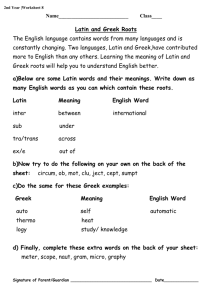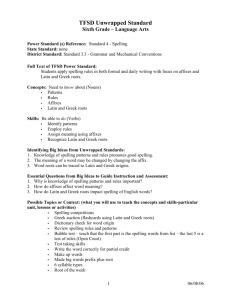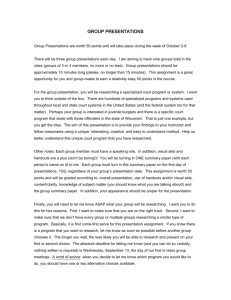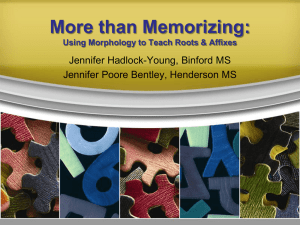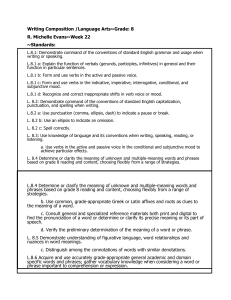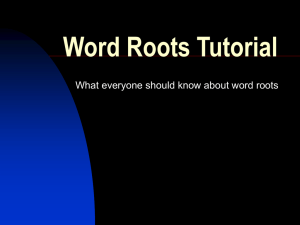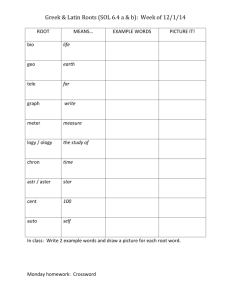SC ELA standards
advertisement
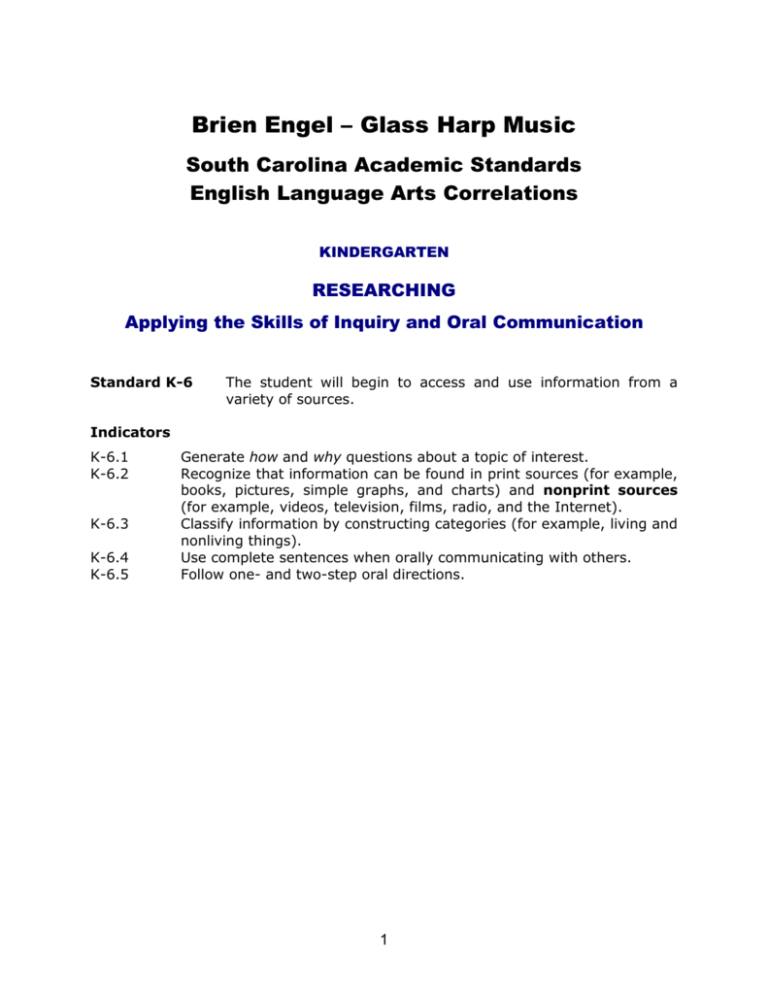
Brien Engel – Glass Harp Music South Carolina Academic Standards English Language Arts Correlations KINDERGARTEN RESEARCHING Applying the Skills of Inquiry and Oral Communication Standard K-6 The student will begin to access and use information from a variety of sources. Indicators K-6.1 K-6.2 K-6.3 K-6.4 K-6.5 Generate how and why questions about a topic of interest. Recognize that information can be found in print sources (for example, books, pictures, simple graphs, and charts) and nonprint sources (for example, videos, television, films, radio, and the Internet). Classify information by constructing categories (for example, living and nonliving things). Use complete sentences when orally communicating with others. Follow one- and two-step oral directions. 1 Grade 1 RESEARCHING Applying the Skills of Inquiry and Oral Communication Standard 1-6 The student will access and use information from a variety of sources. Indicators 1-6.1 1-6.2 1-6.3 1-6.4 1-6.5 1-6.6 Generate how and why questions about a topic of interest. Use print sources of information (for example, books, newspapers, pictures, charts, and graphs) and nonprint sources to access information. Create categories (for example, plants and animals) to classify information. Use the Internet with the aid of a teacher. Use complete sentences when orally presenting information. Follow one- and two-step oral directions. 2 Grade 2 RESEARCHING Applying the Skills of Inquiry and Oral Communication Standard 2-6 The student will access and use information from a variety of sources. Indicators 2-6.1 2-6.2 2-6.3 2-6.4 2-6.5 2-6.6 Generate how and why questions about a topic of interest. Use a variety of print sources (for example, books, pictures, charts, graphs, diagrams, and picture dictionaries) and nonprint sources to access information. Create categories (for example, solids and liquids) to classify information. Use the Internet with the aid of a teacher. Use Standard American English when appropriate in conversations and discussions. Follow multistep directions. 3 Grade 3 RESEARCHING Applying the Skills of Inquiry and Oral Communication Standard 3-6 The student will access and use information from a variety of sources. Indicators 3-6.1 3-6.2 3-6.3 3-6.4 3-6.5 3-6.6 3-6.7 Generate a topic for inquiry. Use print sources (for example, books, magazines, charts, graphs, diagrams, dictionaries, encyclopedias, atlases, and thesauri) and nonprint sources (for example, pictures, photographs, video, and television) to access information. Organize information by classifying or sequencing. Paraphrase research information accurately and meaningfully. Use the Internet as a source of information. Use vocabulary (including Standard American English) that is appropriate for the particular audience or purpose. Use appropriate visual aids (for example, pictures, objects, and charts) to support oral presentations. 4 Grade 4 READING Building Vocabulary Standard 4-3 The student will use word analysis and vocabulary strategies to read fluently. Indicators 4-3.1 4-3.2 4-3.3 4-3.4 Generate the meaning of unfamiliar and multiple-meaning words by using context clues (for example, those that provide an example or a definition). Use base words and affixes to determine the meanings of words. (See Instructional Appendix: Prefixes and Suffixes.) Interpret the meaning of idioms encountered in texts. Spell correctly words with prefixes and suffixes and multisyllabic words. RESEARCHING Applying the Skills of Inquiry and Oral Communication Standard 4-6 The student will access and use information from a variety of sources. Indicators 4-6.1 4-6.2 4-6.3 4-6.4 4-6.6 4-6.7 4-6.8 Clarify and refine a research topic. Use print sources (for example, books, magazines, charts, graphs, diagrams, dictionaries, encyclopedias, atlases, thesauri, newspapers, and almanacs) and nonprint sources to access information. Organize information by classifying or sequencing. Paraphrase research information accurately and meaningfully. Use the Internet as a source of information. Use vocabulary (including Standard American English) that is appropriate for the particular audience or purpose. Select appropriate graphics, in print or electronic form, to support written works and oral and visual presentations. 5 Grade 5 READING Building Vocabulary Standard 5-3 The student will use word analysis and vocabulary strategies to read fluently. Indicators 5-3.1 5-3.2 5-3.3 5-3.4 Use context clues (for example, those that provide an example, a definition, or a restatement) to generate the meanings of unfamiliar and multiple-meaning words. Use Greek and Latin roots and affixes to determine the meanings of words within texts. (See Instructional Appendix: Greek and Latin Roots and Affixes.) Interpret the meaning of idioms and euphemisms encountered in texts. Spell correctly multisyllabic constructions, double consonant patterns, and irregular vowel patterns in multisyllabic words. RESEARCHING Applying the Skills of Inquiry and Oral Communication Standard 5-6 Indicators 5-6.1 5-6.2 5-6.3 5-6.4 5-6.5 5-6.6 5-6.7 5-6.8 5-6.9 The student will access and use information from a variety of sources. Clarify and refine a research topic. Use print sources (for example, books, magazines, charts, graphs, diagrams, dictionaries, encyclopedias, atlases, thesauri, newspapers, and almanacs) and nonprint sources to access information. Select information appropriate for the research topic. Paraphrase research information accurately and meaningfully. Create a list of sources that contains information (including author, title, and full publication details) necessary to properly credit and document the work of others. Use the Internet as a source of information. Use vocabulary (including Standard American English) that is appropriate for the particular audience or purpose. Use appropriate organizational strategies to prepare written works and oral and visual presentations. Select appropriate graphics, in print or electronic form, to support written works and oral and visual presentations. 6 Grade 6 READING Building Vocabulary Standard 6-3 The student will use word analysis and vocabulary strategies to read fluently. Indicators 6-3.1 6-3.2 6-3.3 6-3.4 6-3.5 Use context clues (for example, those that provide an example, a definition, or restatement) to generate the meanings of unfamiliar and multiple-meaning words. Analyze the meaning of words by using Greek and Latin roots and affixes within texts. (See Instructional Appendix: Greek and Latin Roots and Affixes.) Interpret the meaning of idioms and euphemisms encountered in texts. Distinguish between the denotation and the connotation of a given word. Spell new words using Greek and Latin roots and affixes. (See Instructional Appendix: Greek and Latin Roots and Affixes.) RESEARCHING Applying the Skills of Inquiry and Oral Communication Standard 6-6 The student will access and use information from a variety of sources. Indicators 6-6.1 6-6.2 6-6.3 6-6.4 6-6.5 6-6.6 6-6.7 6-6.8 Clarify and refine a research topic. Use direct quotations, paraphrasing, or summaries to incorporate into written, oral, auditory, or visual works the information gathered from a variety of research sources. Use a standardized system of documentation (for example, a list of sources with full publication information and the use of in-text citations) to properly credit the work of others. Use vocabulary (including Standard American English) that is appropriate for the particular audience or purpose. Use appropriate organizational strategies to prepare written works, oral and auditory presentations, and visual presentations. Select appropriate graphics, in print or electronic form, to support written works, oral presentations, and visual presentations. Use a variety of print and electronic reference materials. Design and carry out research projects by selecting a topic, constructing inquiry questions, accessing resources, and organizing information. 7 Grade 7 READING Building Vocabulary Standard 7-3 The student will use word analysis and vocabulary strategies to read fluently. Indicators 7-3.1 7-3.2 7-3.3 7-3.4 7-3.5 Use context clues (for example, those that provide an example, a definition, a restatement, or a comparison/contrast) to generate the meanings of unfamiliar and multiple-meaning words. Analyze the meaning of words by using Greek and Latin roots and affixes within texts. (See Instructional Appendix: Greek and Latin Roots and Affixes.) Interpret the meaning of idioms and euphemisms encountered in texts. Interpret the connotations of words to understand the meaning of a given text. Spell new words using Greek and Latin roots and affixes. (See Instructional Appendix: Greek and Latin Roots and Affixes.) RESEARCHING Applying the Skills of Inquiry and Oral Communication Standard 7-6 The student will access and use information from a variety of sources. Indicators 7-6.1 7-6.2 7-6.3 7-6.4 7-6.5 7-6.6 7-6.7 7-6.8 Clarify and refine a research topic. Use direct quotations, paraphrasing, or summaries to incorporate into written, oral, auditory, or visual works the information gathered from a variety of research sources. Use a standardized system of documentation (including a list of sources with full publication information and the use of in-text citations) to properly credit the work of others. Use vocabulary (including Standard American English) that is appropriate for the particular audience or purpose. Use appropriate organizational strategies to prepare written works, oral and auditory presentations, and visual presentations. Select appropriate graphics, in print or electronic form, to support written works, oral presentations, and visual presentations. Use a variety of print and electronic reference materials. Design and carry out research projects by selecting a topic, constructing inquiry questions, accessing resources, and selecting and organizing information. 8 Grade 8 READING Building Vocabulary Standard 8-3 The student will use word analysis and vocabulary strategies to read fluently. Indicators 8-3.1 8-3.2 8-3.3 8-3.4 8-3.5 Use context clues (for example, those that provide an example, a definition, a restatement, or a comparison/contrast) to generate the meanings of unfamiliar and multiple-meaning words. Analyze the meaning of words by using Greek and Latin roots and affixes within texts. (See Instructional Appendix: Greek and Latin Roots and Affixes.) Interpret the meaning of idioms and euphemisms encountered in texts. Interpret the connotations of words to understand the meaning of a given text. Spell new words using Greek and Latin roots and affixes. (See Instructional Appendix: Greek and Latin Roots and Affixes.) RESEARCHING Applying the Skills of Inquiry and Oral Communication Standard 8-6 Indicators 8-6.1 8-6.2 8-6.3 8-6.4 8-6.5 8-6.6 8-6.7 8-6.8 The student will access and use information from a variety of sources. Clarify and refine a research topic. Use direct quotations, paraphrasing, or summaries to incorporate into written, oral, auditory, or visual works the information gathered from a variety of research sources. Use a standardized system of documentation (including a list of sources with full publication information and the use of in-text citations) to properly credit the work of others. Use vocabulary (including Standard American English) that is appropriate for the particular audience or purpose. Use appropriate organizational strategies to prepare written works, oral and auditory presentations, and visual presentations. Select appropriate graphics, in print or electronic form, to support written works, oral presentations, and visual presentations. Use a variety of print and electronic reference materials. Design and carry out research projects by selecting a topic, constructing inquiry questions, accessing resources, evaluating credibility, and selecting and organizing information. 9
